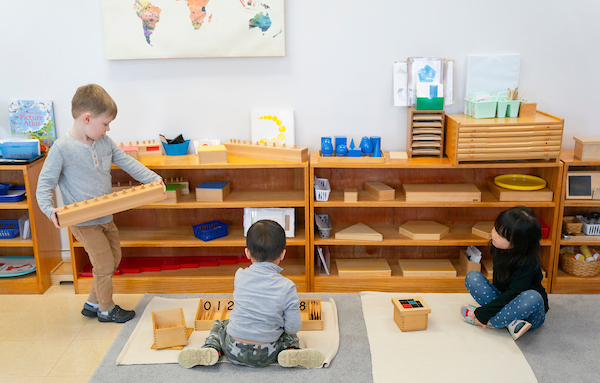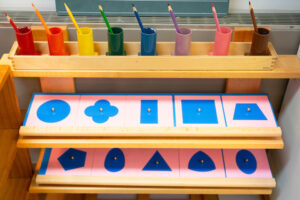What is a ‘Prepared Environment’?

“It is through the environment that the individual is molded and brought to perfection …Since a child is formed by his environment he has need of precise and determined guides and not simply some vague constructive formulae.”
Maria Montessori, The Secret of Childhood
The prepared environment is the center of instruction in the Montessori Method. This week, our faculty has been hard at work calibrating their learning environments to meet the individual needs of every child in their class. Recently, a Birth-to-Three teacher specifically selected a shallow, woven tray for the shelf because it requires a child to place their hands evenly on the sides and walk carefully to avoid spilling the work contents. She knew this tray’s inclusion would help a specific student who needs to practice balance and deliberate movement in the classroom.
This is just one example of our teachers’ thought process: They choose books, arrange seating, shelves, tables, chairs, pencils, and Montessori works in the classroom. Through these carefully engineered decisions, the teacher can channel the learner’s interest in the materials.
The Montessori-prepared environment is designed to attract the child’s attention. It draws them in and encourages them to reach out and engage. Once a child is finished, items in the classroom have a specific place to be housed, thus restoring the environment. This focus on organization meets the child’s psychological needs in the Sensitive Period of order. Having the curriculum in any subject area arranged from start to finish gives children greater liberty to direct their learning and determine their pace and goals.
“When we watch a child in an environment that is his and that evokes response in him, we see that he works by himself toward his own self-perfection. The right way is not only indicated by the objects he picks up, but by the possibility of his recognizing his own errors by means of these objects.
And what should we do?
Nothing.”
Maria Montessori, The Child in the Family
The people within the classroom are also part of the prepared environment. The multi-age classroom means the classrooms have a culture. The older students are leaders and models for their classmates. The prepared teacher is open to observation and adaptation within the classroom as the students’ needs develop and change. The prepared environment continues to evolve alongside the group.
The Montessori environment is organized with familiar systems: shelves are arranged left to right, top to bottom, with materials progressing from simple to complex and concrete to abstract. The Montessori-prepared environment contains spaces for working at tables and on the floor. There is room for working individually, in small groups, and as a whole class community. Dr. Montessori understood that a crucial component of preparing a learning environment is to provide a space for students to learn more about themselves.
“The man who does not live in an adaptive environment can neither develop his faculties normally nor learn to know himself.”
Maria Montessori, The Child in the Family





